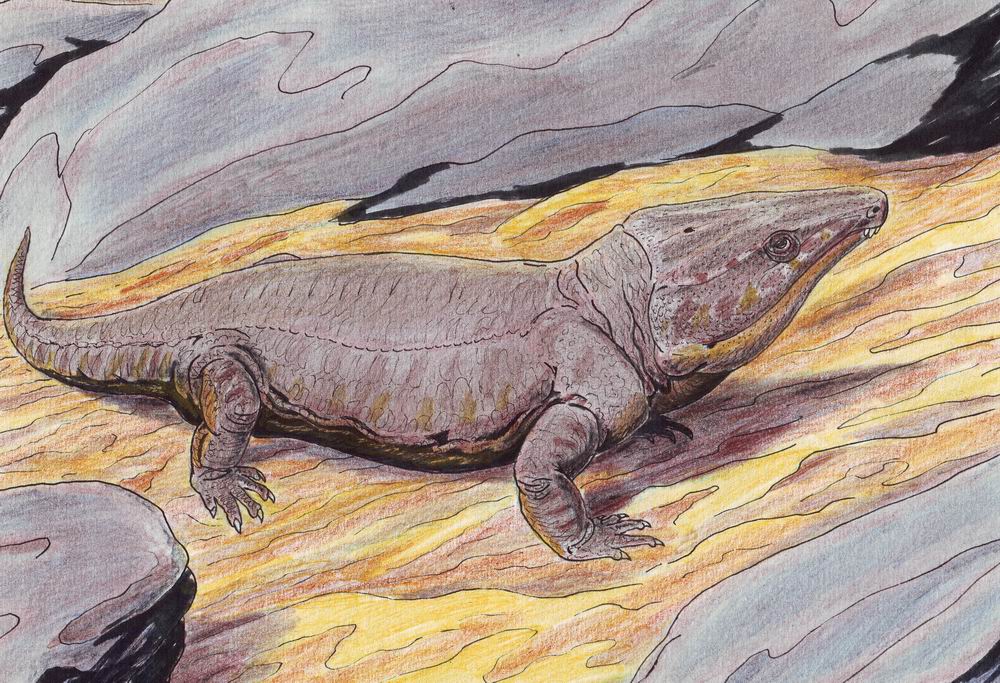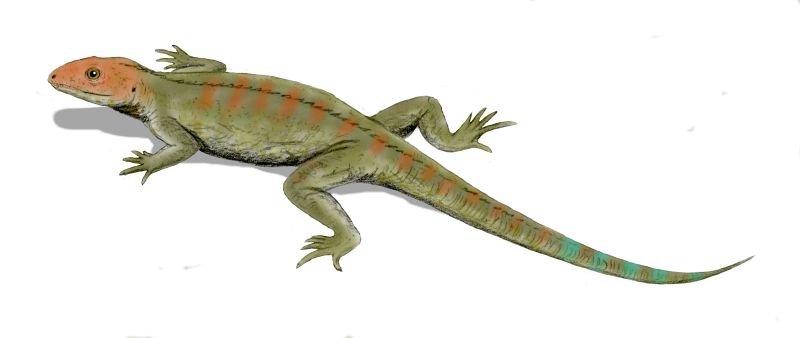|
Eureptilia
Eureptilia ("true reptiles") is one of the two major subgroups of the clade Sauropsida, the other one being Parareptilia. Eureptilia includes Diapsida (the clade containing all modern reptiles and birds), as well as a number of primitive Permo-Carboniferous forms previously classified under Anapsida, in the old (no longer recognised) order "Cotylosauria". Eureptilia is characterized by the skull having greatly reduced supraoccipital, tabular, and supratemporal bones that are no longer in contact with the postorbital. Aside from Diapsida, the group notably contains Captorhinidae, a diverse and long lived (Late Carboniferous-Late Permian) clade of initially small carnivores that later evolved into large herbivores. Other primitive eureptiles such as ''Hylonomus'' and "protorothyrids" were all small, superficially lizard-like forms, that were probably insectivorous. One primitive eureptile, the Late Carboniferous "protorothyrid" ''Anthracodromeus,'' is the oldest known climbing ... [...More Info...] [...Related Items...] OR: [Wikipedia] [Google] [Baidu] |
Parareptilia
Parareptilia ("at the side of reptiles") is a subclass or clade of basal sauropsids (reptiles), typically considered the sister taxon to Eureptilia (the group that likely contains all living reptiles and birds). Parareptiles first arose near the end of the Carboniferous period and achieved their highest diversity during the Permian period. Several ecological innovations were first accomplished by parareptiles among reptiles. These include the first reptiles to return to marine ecosystems (mesosaurs), the first bipedal reptiles (bolosaurids such as '' Eudibamus''), the first reptiles with advanced hearing systems ( nycteroleterids and others), and the first large herbivorous reptiles (the pareiasaurs). The only parareptiles to survive into the Triassic period were the procolophonoids, a group of small generalists, omnivores, and herbivores. The largest family of procolophonoids, the procolophonids, rediversified in the Triassic, but subsequently declined and became extinct by t ... [...More Info...] [...Related Items...] OR: [Wikipedia] [Google] [Baidu] |
Sauropsida
Sauropsida ("lizard faces") is a clade of amniotes, broadly equivalent to the class Reptilia. Sauropsida is the sister taxon to Synapsida, the other clade of amniotes which includes mammals as its only modern representatives. Although early synapsids have historically been referred to as "mammal-like reptiles", all synapsids are more closely related to mammals than to any modern reptile. Sauropsids, on the other hand, include all amniotes more closely related to modern reptiles than to mammals. This includes Aves (birds), which are now recognized as a subgroup of archosaurian reptiles despite originally being named as a separate class in Linnaean taxonomy. The base of Sauropsida forks into two main groups of "reptiles": Eureptilia ("true reptiles") and Parareptilia ("next to reptiles"). Eureptilia encompasses all living reptiles (including birds), as well as various extinct groups. Parareptilia is typically considered to be an entirely extinct group, though a few hypotheses ... [...More Info...] [...Related Items...] OR: [Wikipedia] [Google] [Baidu] |
Thuringothyris
''Thuringothyris'' is an extinct genus of Early Permian eureptiles known from the Thuringian Forest in central Germany. Description ''Thuringothyris'' is known from the holotype MNG 7729, articulated well-preserved skull and partial postcranial skeleton, and from the referred specimens MNG 10652, poorly preserved skull and partial vertebral column, MNG 10647, disarticulated cranial and postcranial remains of at least four individuals, MNG 10183, slightly crushed skull and partial postcranial skeleton and MNG 11191, poorly preserved skull and partial limbs. All specimens were collected from the Tambach-Sandstein Member, the uppermost part of the Tambach Formation, dating to the Artinskian stage of the Late Cisuralian Series (or alternatively upper Rotliegend), about 284–279.5 million years ago. They were found in the Bromacker Quarry, the middle part of the Thuringian Forest, near the small town of Tambach-Dietharz. ''Thuringothyris'' was originally ... [...More Info...] [...Related Items...] OR: [Wikipedia] [Google] [Baidu] |
Reptile
Reptiles, as most commonly defined are the animals in the class Reptilia ( ), a paraphyletic grouping comprising all sauropsids except birds. Living reptiles comprise turtles, crocodilians, squamates ( lizards and snakes) and rhynchocephalians ( tuatara). As of March 2022, the Reptile Database includes about 11,700 species. In the traditional Linnaean classification system, birds are considered a separate class to reptiles. However, crocodilians are more closely related to birds than they are to other living reptiles, and so modern cladistic classification systems include birds within Reptilia, redefining the term as a clade. Other cladistic definitions abandon the term reptile altogether in favor of the clade Sauropsida, which refers to all amniotes more closely related to modern reptiles than to mammals. The study of the traditional reptile orders, historically combined with that of modern amphibians, is called herpetology. The earliest known proto-reptiles originated ... [...More Info...] [...Related Items...] OR: [Wikipedia] [Google] [Baidu] |
Protorothyrids
Protorothyrididae is an extinct family of small, lizard-like reptiles belonging to Eureptilia. Their skulls did not have fenestrae, like the more derived diapsids. Protorothyridids lived from the Late Carboniferous to Early Permian periods, in what is now North America. Many genera of primitive reptiles were thought to be protorothyridids. '' Brouffia'', '' Coelostegus'', '' Paleothyris'' and ''Hylonomus'', for example, were found to be more basal eureptiles in Muller and Reisz (2006), making the family as historically defined paraphyletic, though three genera, ''Protorothyris, Anthracodromeus,'' and '' Cephalerpeton'', were recovered as a monophyletic group. ''Anthracodromeus'', ''Paleothyris'', and ''Protorothyris w''e recovered as a monophyletic group in Ford and Benson (2020) (who did not sample ''Cephalerpeton''), who recovered them as more derived than captorhinids and ''Hylonomus'', but less so than araeoscelidians. ''Anthracodromeus'' is the earliest known reptile to dis ... [...More Info...] [...Related Items...] OR: [Wikipedia] [Google] [Baidu] |
Protorothyrididae
Protorothyrididae is an extinct family of small, lizard-like reptiles belonging to Eureptilia. Their skulls did not have fenestrae, like the more derived diapsids. Protorothyridids lived from the Late Carboniferous to Early Permian periods, in what is now North America. Many genera of primitive reptiles were thought to be protorothyridids. '' Brouffia'', '' Coelostegus'', '' Paleothyris'' and '' Hylonomus'', for example, were found to be more basal eureptiles in Muller and Reisz (2006), making the family as historically defined paraphyletic, though three genera, ''Protorothyris, Anthracodromeus,'' and '' Cephalerpeton'', were recovered as a monophyletic group. ''Anthracodromeus'', ''Paleothyris'', and ''Protorothyris w''e recovered as a monophyletic group in Ford and Benson (2020) (who did not sample ''Cephalerpeton''), who recovered them as more derived than captorhinids Captorhinidae (also known as cotylosaurs) is an extinct family of tetrapods, traditionally consi ... [...More Info...] [...Related Items...] OR: [Wikipedia] [Google] [Baidu] |
Diapsida
Diapsids ("two arches") are a clade of sauropsids, distinguished from more primitive eureptiles by the presence of two holes, known as temporal fenestrae, in each side of their skulls. The group first appeared about three hundred million years ago during the late Carboniferous period. All diapsids other than the most primitive ones in the clade Araeoscelidia are sometimes placed into the clade Neodiapsida. The diapsids are extremely diverse, and include birds and all modern reptile groups, including turtles, which were historically thought to lie outside the group. Although some diapsids have lost either one hole (lizards), or both holes (snakes and turtles), or have a heavily restructured skull (modern birds), they are still classified as diapsids based on their ancestry. At least 17,084 species of diapsid animals are extant: 9,159 birds, and 7,925 snakes, lizards, tuatara, turtles, and crocodiles. Characteristics The name Diapsida means "two arches", and diapsids are tradition ... [...More Info...] [...Related Items...] OR: [Wikipedia] [Google] [Baidu] |
Cephalerpeton
''Cephalerpeton'' is an extinct genus of " protorothyridid" eureptile known from the Late Carboniferous (late Westphalian stage) of Illinois. It is known from the holotype YPM 796, a partial skeleton. It was collected in the Mazon Creek site, from the Francis Creek Shale Member of the Carbondale Formation. It was first named by R. L. Moodie in 1912 as an amphibamid amphibian and the type species is ''Cephalerpeton ventriarmatum''. It was first assigned to Protorothyrididae Protorothyrididae is an extinct family of small, lizard-like reptiles belonging to Eureptilia. Their skulls did not have fenestrae, like the more derived diapsids. Protorothyridids lived from the Late Carboniferous to Early Permian periods, ... by Robert L. Carroll and Donald Baird in 1972 and this placement has been widely accepted. References Prehistoric romeriids Fossil taxa described in 1912 Carboniferous reptiles of North America Prehistoric reptile genera {{carboniferous- ... [...More Info...] [...Related Items...] OR: [Wikipedia] [Google] [Baidu] |
Captorhinidae
Captorhinidae (also known as cotylosaurs) is an extinct family of tetrapods, traditionally considered primitive reptiles, known from the late Carboniferous to the Late Permian. They had a cosmopolitan distribution across Pangea. Description Captorhinids are a clade of small to very large lizard-like reptiles that date from the late Carboniferous through the Permian. Their skulls were much stronger than those of their relatives, the Protorothyrididae, and had teeth that were better able to deal with tough plant material. The postcranial skeleton is very similar to that of advanced reptiliomorph amphibians, so much in fact that the amphibian Seymouriamorpha and Diadectomorpha were thought to be reptiles and grouped together in "Cotylosauria" as the first reptiles in the early 20th century. Captorhinids have broad, robust skulls that are generally triangular in shape when seen in dorsal view. The premaxillae are characteristically downturned. The largest captorhinid, the her ... [...More Info...] [...Related Items...] OR: [Wikipedia] [Google] [Baidu] |
Labidosaurikos
''Labidosaurikos'' is a genus of extinct captorhinid anapsid reptile that lived around 279 to 272 million years ago during Kungurian age of the lower Permian. The American paleontologist John Willis Stovall first described ''Labidosaurikos'' in 1950, naming it "Labidosaurus like" for the striking similarity of the holotype skull of his specimen to the cranial anatomy of another captorhinid ''Labidosaurus hamatus''.Stovall, J.W., 1950. A new cotylosaur from north central Oklahoma. ''American Journal of Science'', 248(1), pp.46-54. ''Labidosaurus'' or generally called "lipped lizard" is another genus of the family Captorhinidae whose name is derived from the Greek for "forceps lizard" based on () ("forceps" or "pinsers") and () ("lizard") ''Labidosaurikos'' is an important find in Permian red beds of North America, where captorhinids are commonly found, as it is a key discovery in the evolution of herbivory in large captorhinids given its multi-row tooth plates.LeBlanc, A.R., ... [...More Info...] [...Related Items...] OR: [Wikipedia] [Google] [Baidu] |
Coelostegus
''Coelostegus'' is an extinct genus of Late Carboniferous (late Westphalian stage) basal reptile known from Pilsen of Czech Republic. It is known from the holotype ČGH 3027, a partial skeleton of an immature individual. It was collected in the Nýřany site from the Nýřany Member of the Kladno Formation. It was first named by Robert L. Carroll and Donald Baird in 1972 and the type species is ''Coelostegus prothales''. The most recent phylogenic study of primitive reptile relationships found ''Coelostegus'' to be the basalmost known eureptile Eureptilia ("true reptiles") is one of the two major subgroups of the clade Sauropsida, the other one being Parareptilia. Eureptilia includes Diapsida (the clade containing all modern reptiles and birds), as well as a number of primitive Permo-C .... References Carboniferous reptiles of Europe Prehistoric eureptiles Fossil taxa described in 1972 Prehistoric reptile genera {{carboniferous-animal-stub ... [...More Info...] [...Related Items...] OR: [Wikipedia] [Google] [Baidu] |
Hylonomus
''Hylonomus'' (; ''hylo-'' "forest" + ''nomos'' "dweller") is an extinct genus of reptile that lived 312 million years ago during the Late Carboniferous period. It is the earliest unquestionable reptile (''Westlothiana'' is older, but in fact it may have been an amphibian, and '' Casineria'' is rather fragmentary). The only species is the type species ''Hylonomus lyelli''. Despite being amongst the oldest known reptiles, it is not the most primitive member of group, being a eureptile more derived than either parareptiles or captorhinids. Description ''Hylonomus'' was long (including the tail). Most of them are 20 cm long and probably would have looked rather similar to modern lizards. It had small sharp teeth and it likely ate small invertebrates such as millipedes or early insects. Fossils of ''Hylonomus'' have been found in the remains of fossilized club moss stumps in the Joggins Formation, Joggins, Nova Scotia, Canada. It is supposed that, after harsh weather, the ... [...More Info...] [...Related Items...] OR: [Wikipedia] [Google] [Baidu] |

.jpg)




